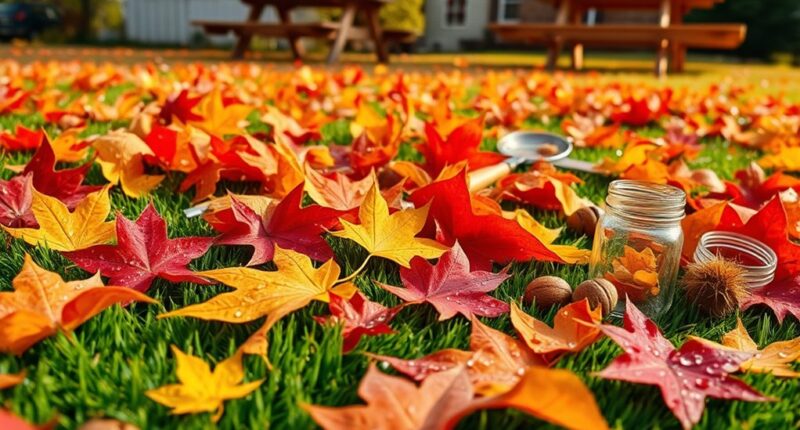To explore fall leaf science with kids, gather colorful leaves from your yard and place them in jars with rubbing alcohol. Let the leaves sit for several hours to watch the chlorophyll break down, revealing hidden pigments like yellows, oranges, reds, and purples. This simple experiment shows how trees prepare for winter and change color. Keep exploring, and you’ll uncover more ways to understand the amazing science behind autumn leaves.
Key Takeaways
- Conduct a simple experiment by soaking colorful leaves in rubbing alcohol to observe how chlorophyll dissolves and reveals hidden pigments.
- Collect various leaves from your yard to compare the different colors and pigments present during fall.
- Understand that as temperatures drop, trees break down chlorophyll, exposing yellow, orange, red, and purple hues.
- Observe how pigment changes visually demonstrate the biological process of leaf color change in a fun, hands-on way.
- Use this experiment to teach kids about plant biology, seasonal changes, and the purpose of leaf color transformation.

Have you ever wondered why leaves change color in the fall? It’s a fascinating process that involves more than just a pretty change in appearance. When you look at a vibrant red or yellow leaf, you’re actually witnessing the results of a complex biological process called the leaf color change, which is closely linked to the photosynthesis process happening inside the leaf. During the warmer months, leaves are green because they contain chlorophyll, the pigment responsible for photosynthesis. Chlorophyll captures sunlight and uses that energy to convert carbon dioxide and water into food for the tree. But as days grow shorter and temperatures drop, trees begin to prepare for winter. They start breaking down chlorophyll, which makes the green color fade away.
Leaves change color in fall as chlorophyll breaks down, revealing vibrant yellow, orange, and red hues.
As the green pigment diminishes, other pigments that were always present but overshadowed by chlorophyll become visible. Carotenoids give leaves their yellow and orange hues, while anthocyanins produce red and purple shades. The leaf color change isn’t just about aesthetics; it’s the tree’s way of reabsorbing valuable nutrients from the leaves before they fall off. When chlorophyll starts to break down, the green fades, revealing these underlying pigments. This entire process is a beautiful example of nature’s seasonal adaptation—saving energy and nutrients for the winter months. Photosynthesis is a vital process that supports the production of these pigments and influences leaf color change.
If you want to explore this process yourself, a simple backyard experiment can help you understand how leaf color change works. Pick a few different leaves from your yard—some that are still green and others that are showing hints of red, yellow, or orange. Place each leaf in a small jar or cup with a little rubbing alcohol and let it sit for a few hours or overnight. As the alcohol dissolves the chlorophyll, you’ll be able to see the other pigments more clearly. This experiment visually demonstrates the breakdown of chlorophyll and gives you a glimpse into the leaf’s hidden colors. It’s a hands-on way to connect with the science behind the seasonal change.
Understanding the photosynthesis process and how it influences leaf color change helps you appreciate the intricate dance of biology and environmental cues. It’s a reminder that nature’s beauty often has a scientific story behind it. By observing these changes in your own yard and trying simple experiments, you can uncover the secrets of fall’s magical transformation and deepen your understanding of how trees adapt to the changing seasons.
Frequently Asked Questions
How Do Different Tree Species’ Leaves Change Color?
You’ll notice that different tree species’ leaves change color uniquely because of variations in chlorophyll breakdown. As days get shorter and temperatures drop, chlorophyll deteriorates, revealing other pigments like carotenoids or anthocyanins. This process causes leaves to display vibrant reds, oranges, or yellows. By observing these changes, you can see how each tree’s pigments reveal themselves at different times, creating a stunning fall display.
What Causes Leaves to Fall at Specific Times?
Coincidences often signal nature’s timing. Leaves fall at specific times because shorter days and cooler temperatures trigger the leaf abscission process, a natural way for trees to conserve resources. As daylight decreases, the photosynthesis process slows down, causing the tree to stop nutrient flow to leaves. This weakens the connection, making leaves fall. You’ll notice this happen in autumn, marking the seasonal change and preparing trees for winter.
Can Leaf Experiments Be Done Indoors?
Yes, you can do indoor leaf experiments easily. Use fresh or dried leaves to explore leaf color pigments by soaking them in alcohol or vinegar, revealing vibrant pigments. You might also observe how different conditions affect leaf color, such as temperature or light. Indoor leaf experiments are fun and educational, helping you understand plant chemistry and seasonal changes without needing outdoor space.
How Do Weather Conditions Affect Leaf Color?
Weather impact plays a big role in leaf pigmentation and color. When temperatures drop and days become shorter, chlorophyll breaks down, revealing other pigments like carotenoids and anthocyanins. Sunny days boost red and purple hues, while cloudy weather can dull leaf colors. You’ll notice that cool nights and dry conditions often produce the most vibrant fall foliage, making weather conditions a key factor in how beautifully your leaves change color.
What Is the Best Way to Preserve Leaves for Science Projects?
Imagine your leaves as tiny treasures waiting to be preserved. To keep them vibrant, use leaf preservation techniques like pressing between heavy books or storing in airtight containers with silica gel. The best storage methods prevent decay and maintain color, so you can enjoy your collection longer. Gently flatten your leaves with a weight or press, then store them in a cool, dry place for the best results.
Conclusion
Now that you’ve explored fall leaf science, you’ve uncovered nature’s tiny mysteries right in your backyard. Just like a detective solving a puzzle, you’ve learned how leaves change color and fall, revealing nature’s secrets. These simple experiments make science fun and easy to understand. So, grab your notebook and keep exploring—each leaf you examine is like a tiny treasure chest full of surprises waiting to be opened! Happy investigating!








